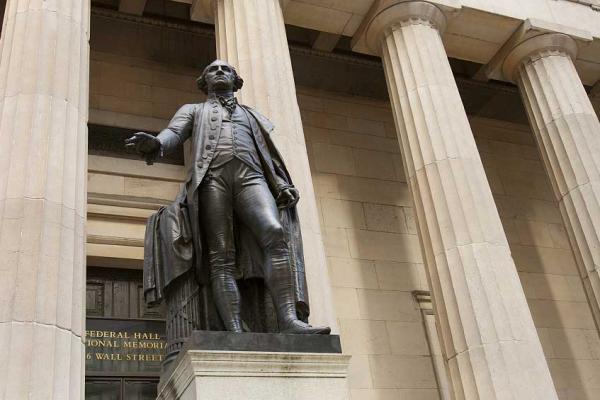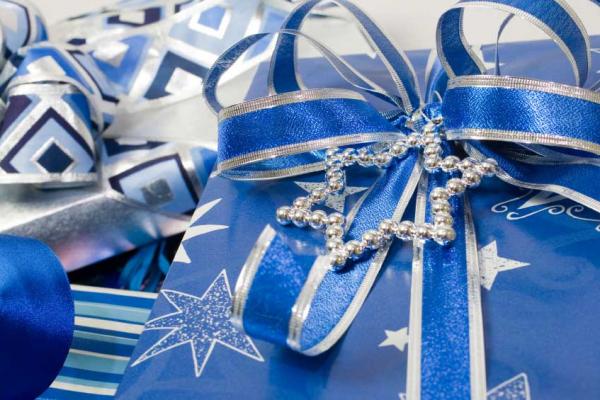Inauguration Day occurs in the USA once every four years on January 20. It occurs in the year after presidential elections have been held. The new terms of office of the president and vice-president officially begin at noon in Washington DC.
 George Washington was the first person to be inaugurated as president of the USA.
George Washington was the first person to be inaugurated as president of the USA.
©iStockphoto.com/Kohlerphoto
What do people do?
On Inauguration Day the candidates, who won the elections in the previous year, are sworn into office as president and vice-president of the United States. The swearing-in ceremony takes place at the U.S. Capitol and is organized by the Joint Congressional Committee on Inaugural Ceremonies. It is usually followed by a parade along Pennsylvania Avenue.
The new president watches the parade from the presidential viewing stand in front of the White House. The route of the parade is often lined by thousands of people. However, many Americans watch the ceremony on television or listen to it on the radio.
Public life
Inauguration Day is not a public holiday and many people are expected to work as usual. Many schools, stores and other organizations are open as normal in many parts of the USA. Public transport services run on their regular schedules. There may be changes to normal broadcasting schedules on television and radio, as news stations cover the inauguration ceremony.
Inauguration Day is a federal holiday for some federal employees who work in the District of Columbia or the surrounding areas. This is mainly to reduce the amount of congestion on the roads and public transit systems of the area.
In and around Washington DC there can be considerable disruption to public life, both on Inauguration Day and in the days before and after the ceremony. This is not only due to the actual ceremony and parades that accompany it, but also the protests and demonstrations that are organized and the massive security operation that takes place. If you have business affairs in this area in the second half of January in an inauguration year, it is wise to check carefully that you will be able to do what you need to.
Background
The head of state of the USA has been a president since 1789. In that year, George Washington was elected and inaugurated as president of the United States of America. He was inaugurated for the first time on April 30, 1789, and for the second time on March 4, 1793. Subsequent inaugurations were held on March 4 until the second inauguration of President Franklin Roosevelt on January 20, 1937. Since then Inauguration Day has been held on January 20 and the term of office officially starts at 12:00 noon on that date.
Usually the vice-president is sworn in first and the president at exactly 12:00 noon. After they have been sworn in, the president and vice-president are given four ruffles and flourishes. The ruffles are played on drums and the flourishes on bugles, which are simple brass instruments with no valves. The ruffles and flourishes form a fanfare before performance of the president’s anthem, “Hail to the Chief”, and the vice-president’s anthem, “Hail, Columbia”. There is then a 21-gun salute from the howitzers of the military district of Washington.
After the ceremony, the president and vice-president are guests of honor at a luncheon given by the United States Congress. Later in the day, they parade down Pennsylvania Avenue and walk part of the way from the Capitol to the White House. If Inauguration Day falls on is a Sunday, the presidential oath is usually administered in a private ceremony on that day and a public ceremony and celebrations are held on the following day.
On January 20, 2009, Barack Obama will be the first African American president to be inaugurated. The results from the USA election, which was held on November 4 in 2008, determined that Obama would be the next president to lead the nation.
Courtesy of TimeandDate.com
Many Jewish communities in the United States observe the first day of Hanukkah, which marks the start of Hanukkah, also known as Chanukah or Festival of Lights. Hanukkah is an eight-day Jewish observance that remembers the Jewish people’s struggle for religious freedom.
 Hanukkah gifts wrapped and ready to be given.
Hanukkah gifts wrapped and ready to be given.
©iStockphoto.com/MarkCoffeyPhoto
What do people do?
Jewish communities in the United States celebrate the first day of Hanukkah on the 25th day of the month of Kislev in the Jewish calendar. The Hanukkah period lasts for eight days and is celebrated from the 25th day of Kislev to the second day of Tevet. The first night of Hanukkah (or Chanukah) starts with special blessings at sunset the day before the 25th of Kislev. Many Jewish people light the hanukiah (or chanukkiyah), which is a type of candelabrum.
Many Americans of Jewish faith also eat food fried in olive oil, such as potato cakes, and different fried breads. Hanukkah dishes include sufganiot (Hanukkah donuts), potato latkes (pancakes), mandelbrot (this can be sliced like a hard bread), and rugelach (pastry that with different fillings). The first day of Hanukkah is the start of a celebratory period in which a four-sided toy called dreidel is used for games. The first night of Hanukkah is also a night when people sing traditional songs to celebrate Hanukkah. Gift-giving is also popular at this time of the year.
Public life
The first day of Hanukkah is not a federal public holiday in the United States. Some Jewish schools have their school vacation fall around the same time of Hanukkah.
Background
Hanukkah commemorates the Jewish people’s successful rebellion against the Greeks in the Maccabean War in 162 BCE. A ritual cleansing and re-dedication of the Temple occurred after the Jewish people’s victory. It is believed that there was only enough consecrated oil to keep the lamp burning for one day but the small bottle of oil miraculously lasted for eight days. Hanukkah, also known as Chanukah, is referred as the Feast of Lights or Festival of Lights for this reason.
Moreover, the survival of Judaism over the many years is also celebrated during this period. The last day of Hanukkah, which marks the end of Hanukkah, falls on the eighth day of this period.
Symbols
The dreidel is a toy that is popular during the Hanukkah celebrations. It is a spinning top with a different Hebrew letter inscribed in each of its four sides – the four letters form an acronym meaning “a great miracle happened here”. The hanukiah (or chanukkiyah) is a type of candelabrum that holds eight candles to commemorate the eight days that the oil burned and a ninth candle that sits apart, known as the shamash, or servant candle that lights the others. One candle is lit on the first night, another on the second, and so forth until all candles are lit on the last night.
About Chanukah/Hanukkah (first day) in other countries
Read more about Chanukah/Hanukkah (first day).
Chanukah/Hanukkah (first day) Observances
Note: Jewish holidays begin at sundown the day before the date specified for the holiday.
Courtesy of DateandTime.com
